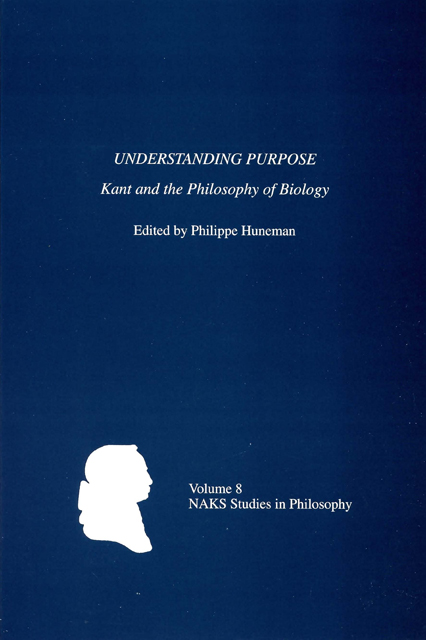Refine search
Actions for selected content:
12661 results in History of science
8 - Critically Engaging with Data Bounds
-
- Book:
- The Life of a Number
- Published by:
- Bristol University Press
- Published online:
- 18 January 2024
- Print publication:
- 28 April 2023, pp 100-120
-
- Chapter
- Export citation
3 - Queer Interests in Technology and Innovation Discourse
-
-
- Book:
- Queering Science Communication
- Published by:
- Bristol University Press
- Published online:
- 18 January 2024
- Print publication:
- 28 April 2023, pp 48-68
-
- Chapter
- Export citation
Contents
-
- Book:
- Queering Science Communication
- Published by:
- Bristol University Press
- Published online:
- 18 January 2024
- Print publication:
- 28 April 2023, pp v-vii
-
- Chapter
- Export citation

Understanding Purpose
- Kant and the Philosophy of Biology
-
- Published by:
- Boydell & Brewer
- Published online:
- 10 March 2023
- Print publication:
- 15 July 2007
References
-
- Book:
- Expertise in Crisis
- Published by:
- Bristol University Press
- Published online:
- 18 January 2024
- Print publication:
- 31 January 2023, pp 93-107
-
- Chapter
- Export citation
Two - Worldviews as “Religious” Frameworks
-
- Book:
- Expertise in Crisis
- Published by:
- Bristol University Press
- Published online:
- 18 January 2024
- Print publication:
- 31 January 2023, pp 36-46
-
- Chapter
- Export citation
Preface
-
- Book:
- Expertise in Crisis
- Published by:
- Bristol University Press
- Published online:
- 18 January 2024
- Print publication:
- 31 January 2023, pp xi-xii
-
- Chapter
- Export citation
Three - The Quasi-Religious Aspect of the Crisis
-
- Book:
- Expertise in Crisis
- Published by:
- Bristol University Press
- Published online:
- 18 January 2024
- Print publication:
- 31 January 2023, pp 47-51
-
- Chapter
- Export citation
Conclusion
-
- Book:
- Expertise in Crisis
- Published by:
- Bristol University Press
- Published online:
- 18 January 2024
- Print publication:
- 31 January 2023, pp 69-71
-
- Chapter
- Export citation
Foreword
-
-
- Book:
- Expertise in Crisis
- Published by:
- Bristol University Press
- Published online:
- 18 January 2024
- Print publication:
- 31 January 2023, pp ix-x
-
- Chapter
- Export citation
About the Author
-
- Book:
- Expertise in Crisis
- Published by:
- Bristol University Press
- Published online:
- 18 January 2024
- Print publication:
- 31 January 2023, pp vi-vi
-
- Chapter
- Export citation
Acknowledgments
-
- Book:
- Expertise in Crisis
- Published by:
- Bristol University Press
- Published online:
- 18 January 2024
- Print publication:
- 31 January 2023, pp vii-viii
-
- Chapter
- Export citation
One - What Caused, and How Do We Fix, Our Crisis?
-
- Book:
- Expertise in Crisis
- Published by:
- Bristol University Press
- Published online:
- 18 January 2024
- Print publication:
- 31 January 2023, pp 20-35
-
- Chapter
- Export citation
Contents
-
- Book:
- Expertise in Crisis
- Published by:
- Bristol University Press
- Published online:
- 18 January 2024
- Print publication:
- 31 January 2023, pp v-v
-
- Chapter
- Export citation
Notes
-
- Book:
- Expertise in Crisis
- Published by:
- Bristol University Press
- Published online:
- 18 January 2024
- Print publication:
- 31 January 2023, pp 72-92
-
- Chapter
- Export citation
Five - Communicating across Worldviews
-
- Book:
- Expertise in Crisis
- Published by:
- Bristol University Press
- Published online:
- 18 January 2024
- Print publication:
- 31 January 2023, pp 58-68
-
- Chapter
- Export citation
Dedication
-
- Book:
- Expertise in Crisis
- Published by:
- Bristol University Press
- Published online:
- 18 January 2024
- Print publication:
- 31 January 2023, pp iii-iv
-
- Chapter
- Export citation
Frontmatter
-
- Book:
- Expertise in Crisis
- Published by:
- Bristol University Press
- Published online:
- 18 January 2024
- Print publication:
- 31 January 2023, pp i-ii
-
- Chapter
- Export citation
Four - Belief as a Form of Expertise
-
- Book:
- Expertise in Crisis
- Published by:
- Bristol University Press
- Published online:
- 18 January 2024
- Print publication:
- 31 January 2023, pp 52-57
-
- Chapter
- Export citation
Introduction
-
- Book:
- Expertise in Crisis
- Published by:
- Bristol University Press
- Published online:
- 18 January 2024
- Print publication:
- 31 January 2023, pp 1-19
-
- Chapter
- Export citation
